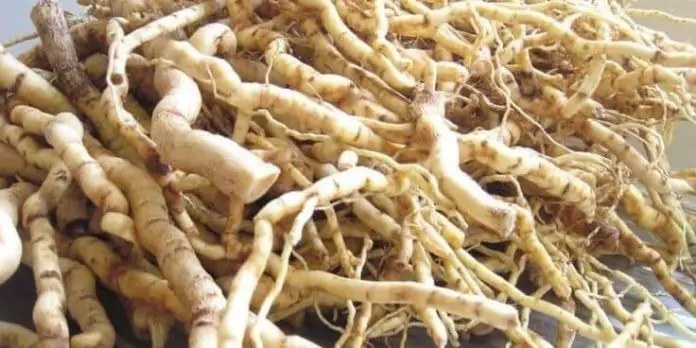Mukombero root, scientifically known as Mondia Whitei, is a popular African plant native to Kenya and other parts of the continent.
It is highly valued for its therapeutic benefits and aphrodisiac effects and has been used in traditional medicine for centuries.
The plant is widespread in Kenya but predominantly grows in the Western and Central parts of the country, where it thrives in the tropics and the rich soils of the natural rain forests.
The entire plant has a wide range of uses, but the most sought-after, high-utility component of the “mukombero” plant is its root.
The root is typically harvested over the dry season, a time when the plant is dormant before being used for various purposes.
Usually, it can be consumed in its raw form, or dried and processed into powder. The root has a sweet flavor with earthy undertones and is commonly sold by street vendors.
In Africa where it is used medicinally, “mukombero” root is thought to alleviate male sexual disorders, including low libido, low sperm count, and erectile dysfunction.
Ask any avid user and they will tell you that the root improves fertility and can stimulate sexual performance.
No wonder the root has been duped the “African Viagra.”
So, why is the “mukombero” root becoming increasingly sought-after?
Is there any scientific background to its purported therapeutic potential?
And what are its safety and legal status?
Let’s investigate…
Uses of “Mukombero” Root in Different Parts of Kenya
“Mukombero” is referred to by a variety of names depending on where you go in Kenya or beyond.
In Kenya, it is commonly known as “ogombo” or “mukombero,” in Tanzania it is called “mbombongazi,” while in Uganda it is referred to as “mulondo”.
The Luo name for this precious root is “ogombo”, which translates to “desire” in English.
Both verbal and written history that has been passed down many generations indicate that among the Luo people, “mukombero” is believed to awaken key life desires, including the desire for sex, happiness, and food. Traditionally, it was used as an appetite stimulant.
Among the Luhya people, the root is natively called “mukombero”, but the entire plant also gets its uses in the community.
The plant’s leaves are used as vegetables, while the roots are also ground into a powdery consistency and used as a flavor for teas or meat stews.
The bark of the plant, on the other hand, is chewed raw to freshen the mouth.
The plant is called “mukombero,” primarily because it has a connection to the Luhya people of Kenya.
You may even argue that it is more or less part of their identity.
Luhya communities that predominantly reside around Kakamega Forest Reserve are accustomed to this plant.
Most of these communities appreciate “mukombero’s” healing properties, and herald it for its ability to treat stroke, asthma, anemia, hypertension, and infertility, among others.
Phytochemistry of the “Mukombero” Root
“Mukombero” plant belongs to the family Apocynacea and has an aerial part that grows up to a height of 6 meters long.
Regarding its phytochemistry, early research conducted by PubMed in 2012 indicated that the root contained several alkaloids, including isovanillin (3-hydroxy-4-methoxybenzaldedyde), 2-hydroxy-4-methoxybenzaldehyde, sugars, and numerous benzaldehyde derivatives.
The biological properties of the “mukombero” root are quite intriguing, which probably explains why Mondia whitei has in recent years gained considerable attention and interest.
Earlier research findings provide evidence to support the use of “mukombero” root as an antidepressant and as an aphrodisiac.
Potential Benefits of Mukombero Root

Most scientific studies on the health benefits of “mukombero” root have been focused on rodents and isolated organ techniques.
That means research is still limited, and the purported benefits cannot be conclusively extrapolated to humans.
Furthermore, many of the root’s traditional medicinal uses are based on anecdotal evidence, as opposed to rigorous scientific research.
Nevertheless, many research findings support the traditional use of the plant for the treatment of various ailments.
Below are some of the scientifically approved benefits of “mukombero” root:
1. Aphrodisiac Properties
There are three known aphrodisiacs, namely; libido, potency, and sexual pleasure.
That said, several studies indicate that “mukombero” root increases testosterone levels, which is a recipe for enhanced sexual desire.
The root was administered in guinea pigs and showed improved erectile function and progressive sperm motility.
Thus, the plant has been suggested to possess therapeutic potential in treating men struggling with low sperm count and erectile dysfunction.
2. Antioxidant Properties
In various studies, “mukombero” root has been found to possess antioxidant activity.
Antioxidants are known to protect the body from oxidative stress and, therefore, keep chronic diseases at bay.
3. Anti-inflammatory Activity
Numerous studies have established the root’s potential as an inhibitor of certain inflammatory markers in the body.
Clinical tests have also indicated that the root could be used to manage chronic pain from inflammatory conditions.
4. Antimicrobial Activity
Laboratory studies have demonstrated the root’s potential as an antimicrobial agent.
It has been shown to protect against certain fungi and bacteria, including Escherichia coli and Staphylococcus aureus.
Safety and Legality
Is “mukombero” root safe?
The answer to this question is simply, yes. The root is generally expected to be safe for intake when harvested, prepared, and used according to traditional practices.
It is a popular medicinal plant that is endemic to Africa and has been used to treat various ailments, including, stress, bilharzia, sexual dysfunction, and general aches or pain.
Researchers have explored its efficacy with regard to its purported uses, and several studies have suggested that it has great medicinal potential.
Locally in Kenya, it is widely used for traditional medicine to the extent that is currently facing the risk of extinction.
The plant is 100% legal, and there are no penalties or legal consequences for possessing or retailing “mukombero” root in any form or shape.
That being said, however, local communities in areas where the plant grows predominantly have overexploited it due to commercialization, and it is facing extinction.
That is mainly because the root is the most sought-after part of the plant, plus there is increasing demand for it both locally and internationally.
In some parts of Kenya, conservation initiatives have been launched to protect the plant from extinction, with an increased focus on large-scale cultivation and sustainable harvesting practices.
Distribution of “Mukombero” root in Kenya
The plant is endemic in almost the entire continent, except for northern Africa.
That is because it grows in moist and wet forests, and is known to thrive in swampy forests, shrubby grasslands, riverine vegetation, wooded Savannah, rain forest margins, and at an elevation of up to 1800 meters above sea level.
In Kenya, the plant primarily grows in the tropical regions of Kenya, including the central strip towards Nyanza, The Rift Valley, and Western Kenya.
The plant thrives in well-drained soils and thick forest undergrowth. It can be found growing naturally in forests, riverbanks, and swamps.
Controversies Surrounding the Use Of Mukombero Root
Mukombero root may boast limitless potential for therapeutic benefits.
However, its spiking demand in recent years has sparked controversy regarding its use.
Some of the concerns and controversies it has generated include:
- The mukombero market in Kenya is still unregulated, and that has raised multiple regulatory issues such as inconsistent product quality, sale of potentially harmful products, etc.
- Most of the plant’s therapeutic benefits are based on anecdotal evidence, and some have argued that its efficacy, safety, and ethnobotanical integrity aren’t scientifically proven. That, coupled with the apparent lack of regulation, has seen some in certain quarters raise concerns about the plant’s potential health risks.
- The rising demand has led to overexploitation of the root. Sellers who leverage the plant’s economic potential are harvesting the root at unsustainable rates, and there are concrete concerns about the plant’s long-term survival.
- Smuggling is another issue regarding mukombero root. Harvesters have recognized that it is a valuable commodity, and there are concerns that middlemen are engaged in illegal trade across the border, especially in neighboring Tanzania. This has raised fears of unsustainable harvesting that could wipe out the plant from the ecosystem.
Conclusion
“Mukombero” root is indigenous to many countries in Africa, including Kenya, and continues to be a significant part of traditional medicine in the country.
It is heralded for its uses and therapeutic benefits, with an emphasis on its aphrodisiac effects and the treatment of sexual dysfunction.
The plant is a traditional remedy for infertility and libido in many parts of Kenya and, indeed Africa.
Many studies have supported its potential in the treatment of different ailments, but more research is needed to ascertain these therapeutic claims.
References
1. https://ijses.com/wp-content/uploads/2020/12/31-IJSES-V4N11.pdf
2. https://www.tandfonline.com/doi/full/10.3109/19390211.2012.726704
4. http://www.edocs.maseno.ac.ke/handle/123456789/3353
5. https://qjoest.com/index.php/qjoest/article/view/71
6. http://stmopenlibrary.com/id/eprint/649/
7. https://www.tandfonline.com/doi/full/10.3109/19390211.2012.726704
9. https://www.phytopharmajournal.com/Vol8_Issue3_07.pdf
10. https://pdf.sciencedirectassets.com/273500/1-s2.0-S0254629911X00042/1-s2.0-S0254629911001001
11. https://academicjournals.org/journal/JPP/article-full-text/CC1D48359696



